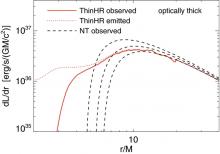
Abstract
Recent general relativistic magneto-hydrodynamic (MHD) simulations of accretion onto black holes have shown that, contrary to the basic assumptions of the Novikov-Thorne model, there can be substantial magnetic stress throughout the plunging region. Additional dissipation and radiation can therefore be expected. We use data from a particularly well-resolved simulation of accretion onto a non-spinning black hole to compute both the radiative efficiency of such a flow and its spectrum if all emitted light is radiated with a thermal spectrum whose temperature matches the local effective temperature. This disk is geometrically thin enough (H/r ~= 0.06) that little heat is retained in the flow. In terms of light reaching infinity (i.e., after allowance for all relativistic effects and for photon capture by the black hole), we find that the radiative efficiency is at least ~=6-10% greater than predicted by the Novikov-Thorne model (complete radiation of all heat might yield another ~6%). We also find that the spectrum more closely resembles the Novikov-Thorne prediction for a/M ~= 0.2--0.3 than for the correct value, a/M=0. As a result, if the spin of a non-spinning black hole is inferred by model-fitting to a Novikov-Thorne model with known black hole mass, distance, and inclination, the inferred a/M is too large by ~= 0.2--0.3.